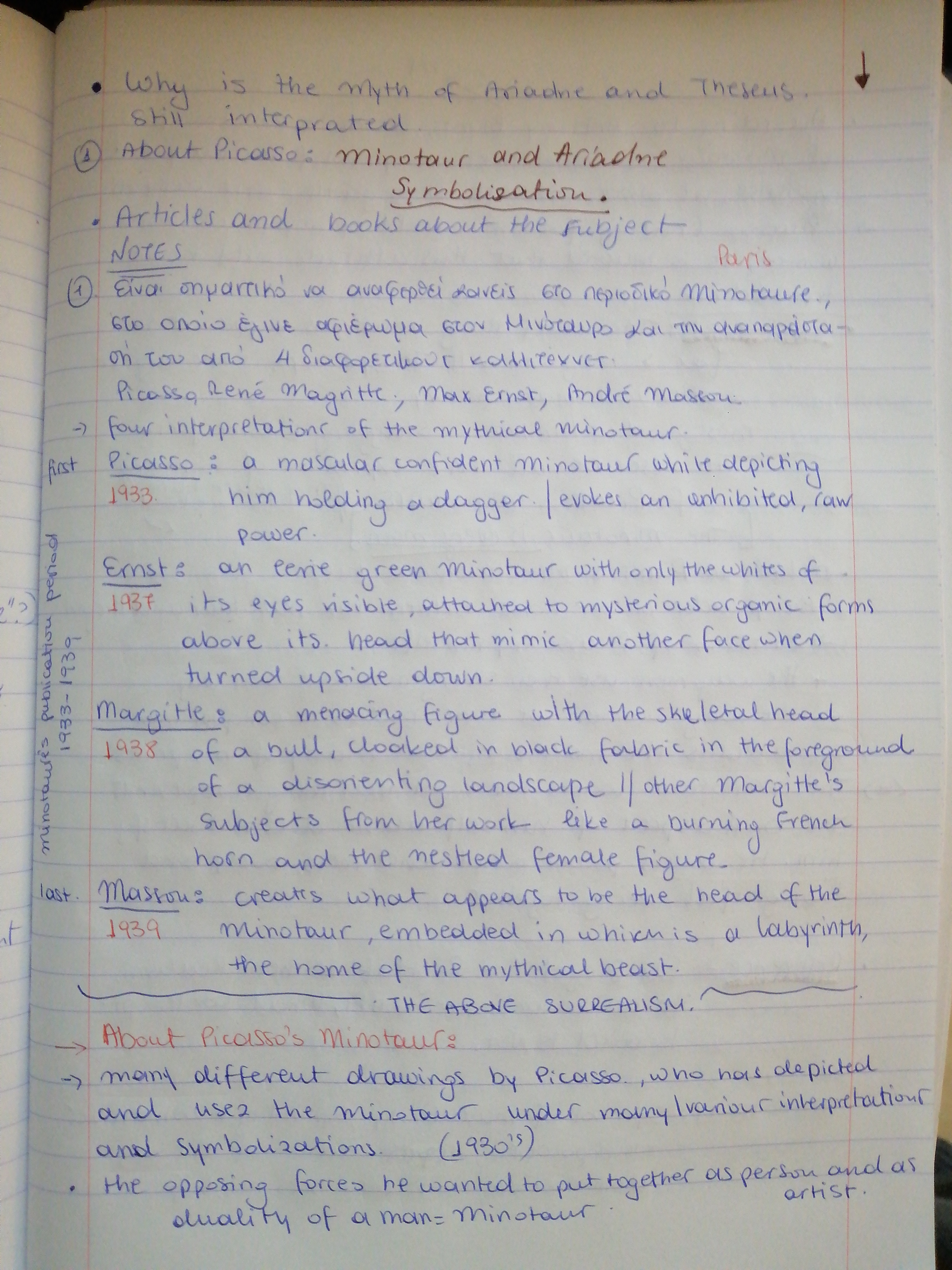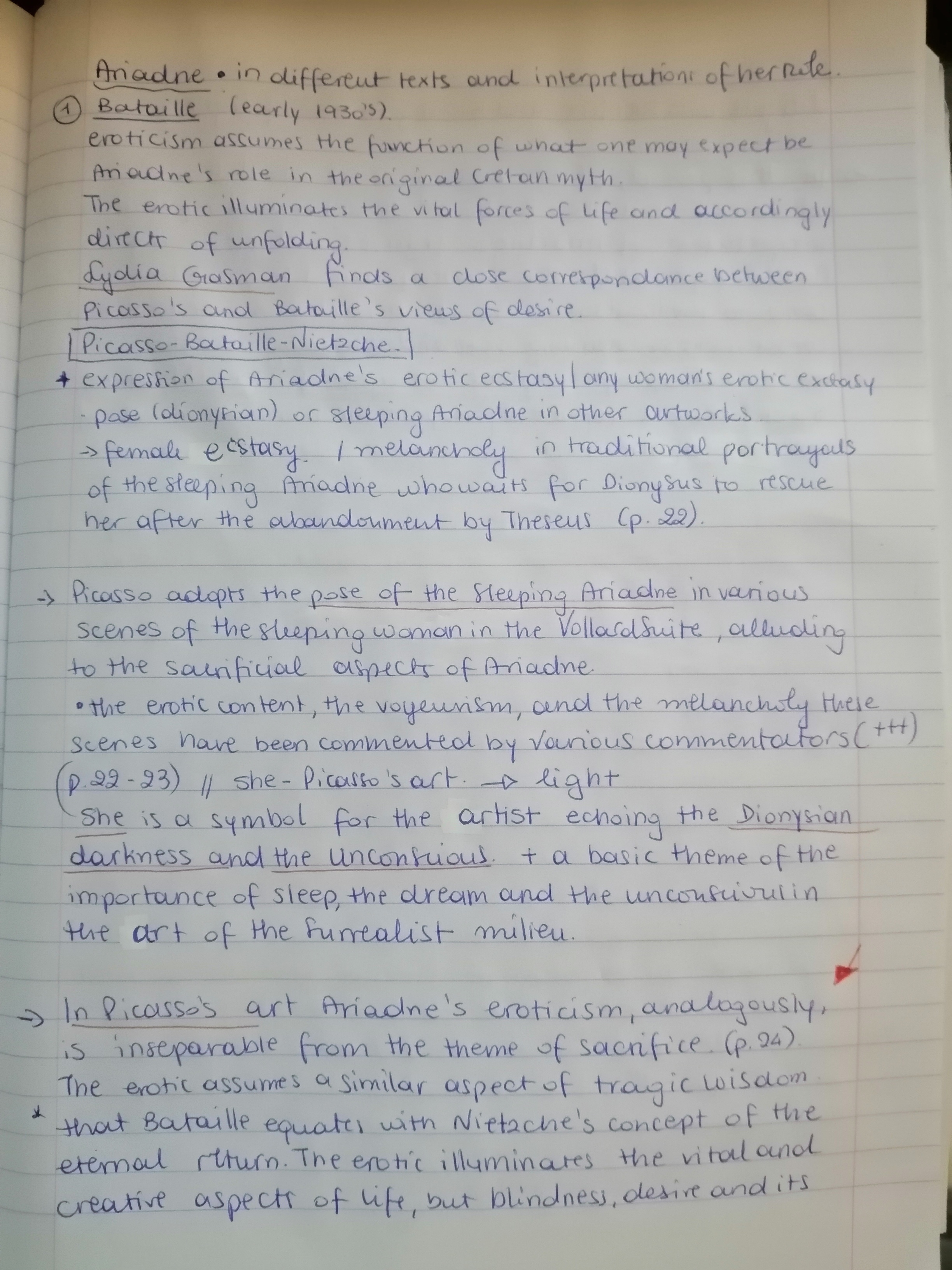New Notebook
Notes on the Myth of Ariadne and Theseus and its Artistic Interpretations

1. Why is the myth of Ariadne and Theseus still interpreted?
The continued interpretation of this myth suggests its profound thematic depth and relevance. It explores concepts of love, sacrifice, and identity, making it a source of inspiration for various artistic representations.
2. About Picasso: Minotaur and Ariadne - Symbolism
- Picasso's exploration of the Minotaur myth reveals his fascination with duality and the human psyche. The Minotaur symbolizes the inner beast within man, reflecting the struggle between civilization and primal instincts.
3. Articles and Books about the Subject
Notes:
- Four interpretations of the mythical Minotaur:
| Artist | Year | Description |
|---|---|---|
| Picasso | 1933 | A muscular, confident Minotaur holding a dagger, representing raw power and unrestrained aggression. |
| Ernst | 1937 | A green Minotaur with eyes mirroring organic forms, suggesting a connection to nature and mystique. |
| Magritte | 1938 | A menacing figure with a bull's skull, cloaked in black; evokes themes of annihilation and isolation. |
| Masson | 1939 | Features what appears to be the head of the Minotaur, symbolizing labyrinthine complexities of desire. |
- Each artist's depiction serves as a reflection of their philosophical and artistic intentions, contributing to a broader understanding of the Minotaur myth.
4. Additional Thoughts on Picasso's Minotaurs
- Picasso created numerous drawings of the Minotaur, which further emphasizes his obsession with this figure. His works serve not only as artistic expressions but also as explorations of his identity as an artist and individual.
- The opposing forces represented in his Minotaur illustrate the complex duality of human nature—depicting both the savage and the civilized elements residing within individuals.
Reference:
Notes on the Myth of Ariadne and the Minotaur

Key Points
-
Ariadne's Role:
- The image discusses Ariadne's perception of being a subject in the narrative surrounding the Minotaur.
- Thoughts: This reflects the theme of isolation in myth; Ariadne aids Theseus but is often left abandoned. Her portrayal can symbolize the nuances of love and betrayal in their relationship.
-
Artistic Representations:
- Mention of Darius Milhaud and his contributions to art connected with the myth.
- Additional Info: Milhaud created pieces that explore the emotional landscape of the characters in the myth, allowing for a deeper understanding of their psychological states.
-
Elliot Carter's Ballet Suite:
- The suite includes a series of 10 drawings depicting the Minotaur, highlighting key moments in the myth.
- Thoughts: This implies a visual narrative that complements the classical text, offering fresh interpretations of traditional motifs.
-
Thematic Exploration:
- Themes of loneliness and alienation are prevalent, particularly regarding the Minotaur's existence as a being that straddles both humanity and monstrosity.
- Further Insight: This duality can reflect on larger societal themes, questioning what it means to be accepted in a world that often demonizes those who are different.
Summary of the Extracted Information
| Year | Artist | Work Description |
|---|---|---|
| 1937 | Darius Milhaud | Produced artistic interpretations related to the open subject of Ariadne and the Minotaur. |
| 1947 | Elliot Carter | Created "The Minotaur," a ballet suite featuring a series of drawings and etchings. |
Overall, the notes reflect an ongoing examination of the myth of Ariadne and Theseus, underscoring how various artists have interpreted this tale through different mediums and perspectives, tapping into its deep psychological and emotional layers.
Reference:
Notes on Picasso's Minotaur and Associated Themes

-
Minotaur as Symbol
The Minotaur exemplifies the struggle between civilization and primal instincts, illustrating the conflict inherent in human nature. This reflects Picasso's personal exploration of identity and artistic purpose, considering the Minotaur's duality as both beast and human. -
Connection to Art and Women
The text mentions the Minotaur's association with women, suggesting a recurring theme in Picasso's work where the Minotaur is depicted in a domestic realm surrounded by women. This might indicate Picasso's complicated relationship with femininity and how it influences his artistic expression. -
Cretan Influence
References to the specific theme of Cretan frescoes highlight the cultural and artistic heritage that informs Picasso's interpretation of the Minotaur myth. The significance of Cretan mythology in relation to art emphasizes how historical narratives shape modern artistic sensibilities. -
Artistic Obsession
The notes imply that Picasso's fixation on the Minotaur evolved over time, demonstrating how his engagement with the figure deepened, leading to a broader discourse on identity and artistic creation. This could reflect broader themes of creativity, obsession, and the artist's role in society. -
Ethical and Political Undertones
The connection drawn between the Minotaur and the ethical convictions of the Surrealists hints at a deeper political commentary in Picasso's work. It suggests that art is not just a personal exploration but also a response to societal issues, akin to the Surrealist methods of juxtaposition and subconscious exploration. -
Recommended Reading
Sections mentioned (specifically Chapters 3 and analyses on Picasso and the Minotaur) are crucial for gaining a deeper understanding of how Picasso’s artistic expressions are intertwined with myth, identity, and the evolution of modern art practices. Engaging with these texts can offer further insights into the broader implications of the Minotaur myth in contemporary artistic narratives.
Reference:
Notes on the Journal "Miniature"

Introduction
- The journal "Miniature" aims to be genuinely multidisciplinary, exploring various attempts to interpret symbolic meanings in the arts.
- Thoughts: This position highlights the importance of a holistic approach to understanding art, which can draw from multiple fields such as mythology, philosophy, and psychology.
Contributions to the Journal
- A painter critiqued the contributions to "Miniature," providing a scholarly perspective on its thematic explorations.
- Additional Information: Engaging artists in critical discussions can enrich the discourse around contemporary interpretations of classical themes.
Thematic Focus
- The journal discusses the Minotaur legend, emphasizing its historical and cultural significance.
- Ideas: The Minotaur can symbolize various themes, including the duality of man, inner conflict, and the manifestation of primal instincts.
- Context: Linking back to the previous notes, the Minotaur serves as a powerful metaphor for the struggle between civility and one's inherent nature.
Case Study: The Minotaur
- The chapter titled "The Beast within the Thread Outside" explores the philosophical implications and artistic interpretations of the Minotaur.
- Thoughts: This could lead to discussions about how mythical creatures serve as allegories for human experiences, reflecting both fear and fascination.
Summary of Findings and Implications
- The journal's exploration of the Minotaur legend provides a rich tapestry of insights that enhance understanding of contemporary art practices.
- Ideas: Future research could investigate how different cultures interpret similar myths and their relevance across time periods.
This comprehensive approach in "Miniature" not only celebrates artistic endeavors but also invites deeper intellectual engagement with cultural narratives.
Reference:
Notes on the Myth of Ariadne and Theseus

-
Contextual Background
- The notes discuss the significance of the myth of Ariadne in relation to contemporary interpretations. This myth has been a focal point for exploration in art and philosophy, particularly regarding human nature and relationships.
- The reference to Nietzsche and figures like Picasso highlights the interdisciplinary connections between philosophy and visual art, showcasing how myths are reinterpreted across different fields.
-
Themes Explored
- Sacrifice and Redemption: The myth often reflects themes of sacrifice, particularly Ariadne’s role in aiding Theseus. This opens discussions about the nature of love and selflessness in relationships.
- Thoughts: Understanding sacrifice can lead to deeper insights into modern relationships, where expectations and dependencies often blur.
- Identity and Interpretation: The author's mention of varying interpretative approaches reveals how personal experiences shape our understanding of myths. Each artist brings their interpretation, reflecting individual emotional and philosophical contexts.
- Additional Insight: This notion celebrates the fluidity of myth as a concept that evolves with time and cultural shifts.
- Sacrifice and Redemption: The myth often reflects themes of sacrifice, particularly Ariadne’s role in aiding Theseus. This opens discussions about the nature of love and selflessness in relationships.
-
Artistic Representations
- The notes allude to Picasso’s work concerning the Minotaur, symbolizing the complexity of the human psyche and duality—representing savagery versus civilization.
- Idea: This link to Picasso's art illustrates how visual representations can augment the understanding of literary and mythological themes, thereby enriching cultural discourse.
- The notes allude to Picasso’s work concerning the Minotaur, symbolizing the complexity of the human psyche and duality—representing savagery versus civilization.
-
Philosophical Implications
- Citing figures like Nietzsche suggests an inquiry into deeper philosophical questions surrounding human existence and morality, inspired by myth.
- Thought: Engaging with these philosophical texts alongside mythological narratives can encourage a more comprehensive philosophical inquiry into existence, ethics, and identity.
- Citing figures like Nietzsche suggests an inquiry into deeper philosophical questions surrounding human existence and morality, inspired by myth.
-
Relevance of Ariadne Myth Today
- The continual relevance of the Ariadne myth in contemporary culture invites discussions on personal narratives and societal roles.
- Reflection: Assessing how these ancient myths influence modern storytelling provides insight into recurring patterns within human behavior, illustrating timeless struggles and aspirations.
- The continual relevance of the Ariadne myth in contemporary culture invites discussions on personal narratives and societal roles.
Overall, the notes capture a nuanced exploration of the myth of Ariadne and its implications across various disciplines, emphasizing its timeless relevance and the interplay between art, philosophy, and human experience.
Reference:
Ariadne: Different Texts and Interpretations

-
Bataille (Early 1930s)
- Key Idea: Eroticism operates as a central function in understanding Ariadne's character within the context of the Cretan myth.
- Thoughts: This perspective suggests that Ariadne's experience is not just a backdrop to Theseus's story but a crucial part of the narrative that reveals deeper philosophical themes about life and existence.
- Gydia Gasman's Perspective: Highlights a connection between Picasso's and Bataille's views on desire.
- Additional Information: This indicates a rich dialogue between visual and literary interpretations of desire that can deepen our understanding of both creators' works.
- Key Idea: Eroticism operates as a central function in understanding Ariadne's character within the context of the Cretan myth.
-
Picasso-Bataille-Nietzsche
- Expression of Ariadne's Erotic Ecstasy:
- Note: The notion of "sleeping Ariadne" features prominently in various artworks, illustrating the multifaceted nature of her character.
- Thoughts: This may symbolize various interpretations of femininity and sacrifice in art.
- Female Ecstasy and Melancholy:
- Note: Represents traditional portrayals of Ariadne in her awaiting role for Dionysus.
- Thoughts: This reflects a complex emotional landscape of longing and abandonment, highlighting the emotional depth of her character.
- Picasso's Interpretation:
- Note: Includes depictions of Ariadne that demonstrate both erotic content and melancholic themes.
- Additional Information: Suggests that Ariadne serves as a dual symbol for both uninhibited creativity and the darker, unconscious aspects of human experience.
- Expression of Ariadne's Erotic Ecstasy:
-
Themes in Picasso's Art
- Ariadne as a Symbol:
- Note: She symbolizes the artist and serves as a representation of the Dionysian theme of darkness and the unconscious.
- Thoughts: This connection encourages exploration into how the unconscious informs artistic creation and expression.
- Importance of Sleep and Dreams:
- Note: Highlights the theme of the unconscious in the context of the surrealist movement.
- Additional Information: This reflects a broader cultural movement that valued the exploration of dreams as a means to understand reality.
- Ariadne as a Symbol:
-
Ariadne's Sacrifice:
- Note: Ariadne’s eroticism is intricately linked with the theme of sacrifice.
- Thoughts: This presents the idea that eroticism is not just a personal experience but is tied to larger existential and moral questions.
- Bataille and Nietzsche:
- Note: Contrasts erotic expression with notions of tragic wisdom and eternal return.
- Additional Information: This ties into philosophical discussions about the cyclical nature of life, drawing upon Nietzsche's ideas and the inherent tension in human desires.
- Note: Ariadne’s eroticism is intricately linked with the theme of sacrifice.
This summary provides a comprehensive overview of the artistic interpretations surrounding Ariadne, emphasizing various emotional and philosophical themes present in her portrayal across different art forms.
Reference: